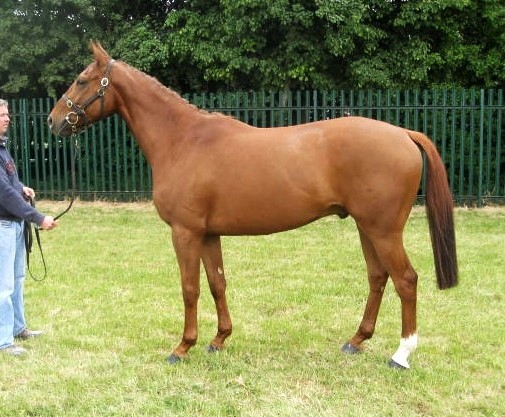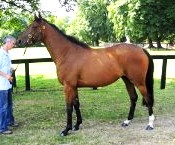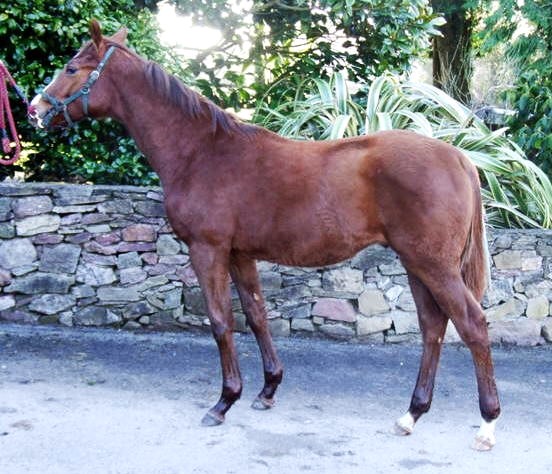
Looking back, I am not sure why we even attended the DBS November Sale in 2005, because the catalogue was an indifferent one, with few mares worth looking at. One of the few was Dancing Pearl, who possessed a moderate pedigree but had shown herself to be a very decent hurdler, winner of four races and over £50,000, with a peak Official Rating of 124 and RPR of 128.
She proved to be a medium-sized mare with good depth and forelimbs, but rather straight hocks and a walk that we scored as ‘7 out of 10’. She was for sale since the owners thought it best to part with her whilst she was still young enough to attract attention as a broodmare.
At the auction Pearl was unsold for 15,000 gns, which I thought much too high a reserve. We offered 10,000 but this was rejected, although we gave our number to the owners should they wish to reconsider. A few weeks later, Pearl pulled up in a race at Southwell and the trainer rang us to say that £10,000 would be acceptable. We bought her subject to agreeing that she could run one more time. In the event, this was one of her best performances: second, giving weight, to She’s Our Native at Ludlow. This raised her Official Rating to 125, which years later qualified her for the TBA Elite Mares Breeding Incentive Scheme.
Pearl’s first mating was to Alflora, a big, good-looking stallion chosen because (a) he might put ‘legs’ on the foal and (b) he would introduce 3×3 inbreeding to Nijinsky, which I thought was a good idea at the time since Kauto Star was similarly inbred to Mill Reef (I now know it wasn’t all that relevant).
The resulting foal, born after Pearl forced him out despite the fact that one knee was bent back for delivery, was a lengthy, lumbering, rather plain chestnut who was a long way from being Kauto Star II. As a three-year-old he brought only £3,000 at the DBS May Sales; but, despite being given plenty of time to mature, Glenford Dorie’s best run out of six attempts under Rules was fourth in a moderate maiden hurdle, 24 lengths behind the winner. He subsequently failed to gain a place in three Point-to-Points.

Pearl’s second foal was a filly by Milan, a sire that was showing up well in my analyses of NH stallion statistics. He continued to do so, but I never used him again. The day she was weaned the foal started wind-sucking furiously. Initially medium-sized but strong, she became a small, ribby individual that failed to thrive. At two she suffered repeated colic attacks due to severe redworm damage (despite having been wormed regularly) and had to be put down. When Michael Moore told me that three Milan geldings in his care had also shown stable vices, it suggested that Milan was too big a risk to use again, despite his excellent statistical record.
The following year’s foal was a colt by Kayf Tara, an attractive but rather small bay. He brought £5,000 as a foal and 13,000 euros when reoffered at three. Named Keeffe’s Well, he showed promise in his first bumper, but afterwards failed to reach the frame in four further races under Rules and in Point-to-Points.

Next, born in 2011, came Sweety Poppet, named after the rhyme I used to chant to calm her (and possibly me) when leading her out as a foal (“Sweety Sweety Poppet, Sweety little girl, The sweetest little Poppet, The best in all the world.”) I kept her with initial hopes of racing her in France as a three-year-old, but Denis Leahy, who broke her, suggested she either wasn’t forward enough or not good enough.

She was then transformed into a trainee show jumper, in which metier she was like the little girl ‘who when she was good was very, very good; but when she was bad she was awful’. So she didn’t make it in that capacity either, and eventually we sold her at Ascot where she brought only £600 to go to Ireland. Two years later, she finished third in her first Point-to-Point but showed nothing in the next two. As is so often the case, Denis was correct as regards her ability.
Pearl continued the boy-girl-boy-girl pattern for the last pair of her foals that I was involved in producing. The 2012 colt was a strong chestnut by Schiaparelli with rather sloping pasterns, who sold for 2,000 euros as a foal to Dick Frisby (who had purchased Keeffe’s Well), whilst the 2013 filly by Black Sam Bellamy, born after I had given Pearl to Peter Hockenhull late in 2012, was sold privately as a yearling. Neither they, nor any of her subsequent progeny, won a race.

Pearl was a good, tough mare herself but a very disappointing broodmare. It would have been best had we never attended that particular Doncaster Sale!
